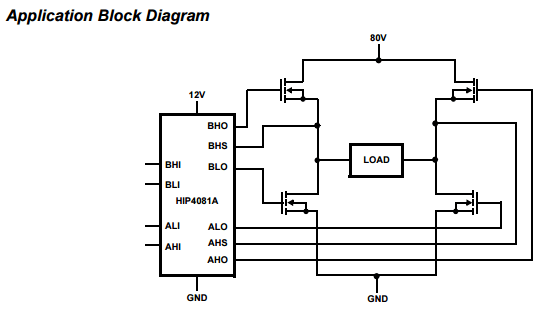Full Bridge Mosfet Driver
Gate Driver ICs have a variety of configurations (high side, low side, half bridge, three phase, current sense), voltage classes (200 V, 500 V, 600 V, 1200 V, 1700 V), isolation levels (functional levelshift, non-isolated, galvanic isolation), protection feature and package options. The A3922 is an N-channel power MOSFET driver capable of controlling MOSFETs connected in a full-bridge (H-bridge) arrangement and is specifically designed for ASIL automotive applications with high-power inductive loads, such as brush DC motors, solenoids and actuators.
The PWD13F60 is a high density power driver integrating gate drivers and four N-channel power MOSFETs in dual half-bridge configuration. The integrated power MOSFETs have a low RDS(on) of 320 mΩ and 600 V drain-source breakdown voltage, while the embedded gate drivers high-side can be easily supplied by the integrated bootstrap diode. Corel draw x4 full version filehippo free. The high integration of the device allows loads in a tiny space to be driven efficiently. The PWD13F60 accepts a supply voltage (VCC) extending over a wide range and is protected by a low voltage UVLO detection on the supply voltage.

The input pin extended range allows easy interfacing with microcontrollers, DSP units or Hall effect sensors. The EVALPWD13F60 is 48 x 53 mm wide, FR-4 PCB resulting in an Rth(J-A) of 18 °C/W, capable to drive loads up to 2 ARMS, without forced airflow cooling. Both controlling and power signals are available on pin strip for easy connection to customer's board. Key Features • Power system-in-package integrating gate drivers and high-voltage power MOSFETs: Low RDS(on) = 320 mΩ, BVDSS = 600V • Suitable for operating as: Full-bridge or Dual independent half-bridges • Wide input supply voltage down to 6.5 VUVLO protection on supply voltage • 3.3 V to 15 V compatible inputs with hysteresis and pull-down • Interlocking function to prevent cross conduction • Internal bootstrap diodes.
I have a full bridge MOSFET driver driver driving a full bridge.  After some experimenting with the circuit prototype i found out that the driver heats up to over 60 °C after a short while of running, which concerned me but it worked fine. However as I decreased impedance across the load (which was originally connected to primary coil of a transformer) the driver started acting in a weird way and i found out that it has blown out. This is already the second driver i destroyed this way and they're expensive as hell, so I need a solution. I think what's causing the driver to blow out is that when I decrease impedance across the load I basically create a short circuit between the driver's bootstrap pin and ground, which kills it.
After some experimenting with the circuit prototype i found out that the driver heats up to over 60 °C after a short while of running, which concerned me but it worked fine. However as I decreased impedance across the load (which was originally connected to primary coil of a transformer) the driver started acting in a weird way and i found out that it has blown out. This is already the second driver i destroyed this way and they're expensive as hell, so I need a solution. I think what's causing the driver to blow out is that when I decrease impedance across the load I basically create a short circuit between the driver's bootstrap pin and ground, which kills it.
By adding a resistor across the load or the whole bridge and ground, I could easily solve the issue, however I do need low impedance on the load because I need high current (up to 20A). I thought about adding a resistor across the driver's bootstrap line, but I have concerns about it affecting the bootstrapping functionality.

EDIT: I'm actually using IGBTs in place of MOSFETs (specifically IRGPS4067DPBF) Also I'm not posting a layout because the full bridge is not on a PCB but it's simply bridge-soldered to the driver circuit. The full bridge operates at 150 kHz square wave.Both circuit and load voltage is 12v Also here's my circuit schematic: The full bridge is connected as in the driver's datasheet, except the feedback loop and shunt resistor: Here's the control circuit layout: And here's the picture of the bridge. $ begingroup $ Show us a picture, please. There was a recent case (maybe 2-3 weeks ago) of a guy blowing his bridge driver. So I told him to put decoupling caps on the power rail and that solved it. Fast switching of a high current combined with supply wire inductance to create a nasty L*di/dt spike which blew the chips. It wasn't load inductance in this case, simply the power supply wires.
The nastiness (di/dt) is proportional to the current, so I'm not surprised it works at low current then blows when current gets high. $ endgroup $ – May 18 '17 at 16:38 •. Your layout may be sloppy. Blowing the driver out at high load current (as opposed to shoot through, which is independent of current) usually indicates that you have stray inductance which is causing excursions at the driver output that are unacceptable. Try adding some reasonable series gate resistance (15 or 20 ohms) and clean up your layout to minimize loop areas that carry load current. Make sure you have bypass capacitors on the 80V and 12V buses. Generally 150kHz is quite a high switching frequency for IGBTs, also IGBTs are not a very good choice at low voltage- they have a lot of voltage drop.